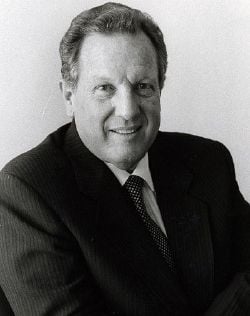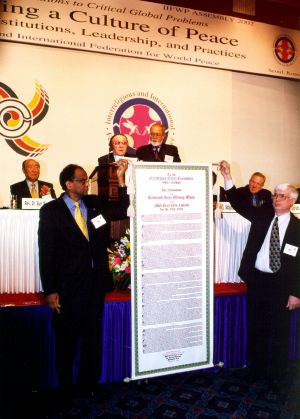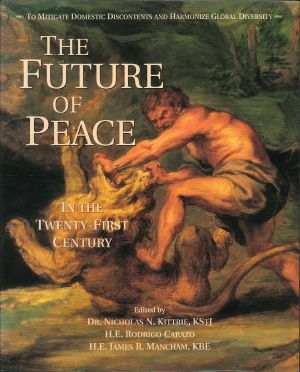Rodrigo Carazo Odio
| Rodrigo Carazo Odio | |

| |
38th President of Costa Rica
| |
| In office May 8, 1978 â May 8, 1982 | |
| Vice President(s)  | Rodrigo Altmann Ortiz JosĂ© Miguel Alfaro RodrĂguez |
|---|---|
| Preceded by | Daniel Oduber Quirós |
| Succeeded by | Luis Alberto Monge Ălvarez |
| Born | December 27 1926 Cartago, Costa Rica |
| Died | December 9 2009 (aged 82) San José, Costa Rica |
| Political party | Unity Coalition (Current Social Christian Unity Party) |
| Spouse | Estrella ZeledĂłn Lizano (m. 1947â2009; his death) |
| Signature | |
Rodrigo JosĂ© RamĂłn Francisco de JesĂșs Carazo Odio (December 27, 1926 â December 9, 2009) served as President of Costa Rica from May 8, 1978 to May 8, 1982.[1]
Despite many positive programs and high initial popularity, Carazo could not overcome falling coffee prices, Costa Rica's main crop, and rising oil prices. As a result his administration came to be popularly identified with high inflation and declining living standards.
During and after his political career, Carazo was involved in efforts to educate peacemakers. He was the founder of the University for Peace, established by United Nations General Assembly Resolution 35/55 in 1980.
Life
Rodrigo Carazo was born in Cartago, Costa Rica. He obtained his degree in economic and social sciences from the University of Costa Rica in 1951.
He married Estrella ZeledĂłn Lizano in San JosĂ© on April 16, 1947. The couple had five children: Rodrigo Alberto, Mario Ernesto, Jorge Manuel, Ălvaro, and Rolando Martin.[2] Their son, Rolando, was killed in a motorcycle accident in Rohrmoser, Costa Rica, in December 1979 at the age of 26.[2]
Carazo died from heart failure and multi-organ failure at the Hospital México in San José on December 9, 2009, at the age of 82. He was survived by his wife, former First Lady Estrella Zeledón Lizano, and four of their five children.[2]
Career
Before entering politics, Carazo served as professor at the University of Costa Rica, Manager of the National Institute of Housing and Urbanism, General Manager for RECOPE (Costa Rica's nationalized oil refinery business), and Director of the Central Bank of Costa Rica. In Panama he was advisor to the Housing Institute and in Venezuela advisor to the Banco Obrero and administrator of five industrial companies.
He served at the national level during the first elected presidency of JosĂ© Figueres Ferrer (1953â1958). He also held positions in Francisco Orlich Bolmarcich's administration (1962â1966).
He then served as President of the Legislative Assembly of Costa Rica in the period 1966-1970.[3]
Presidency
Carazo came to power on May 8, 1978, with popular support for reform, heading the Unity Coalition after internally competing for the candidacy with Miguel Barzuna. This Coalition was the seed of what became the Social Christian Unity Party.
As president, he concentrated on and promoted the country's petrochemical industry and even began exploration and digging near the Talamanca Mountain Ridge in search for petroleum. In the energy sector, his government inaugurated the hydroelectric plant in Lake Arenal. The Carazo government also regulated the excavation of gold in the southern region of the country.
On the international front, Carazo had to deal mainly with the radical changes in the neighboring country of Nicaragua, which had been under the control of the Somoza dictatorship for decades, whose rule Costa Rica had always opposed. As the Sandinista movement rose in the 1970s, Nicaragua was faced with civil unrest and small armed clashes. Costa Rica's government supported any power against Somoza and so backed backing to the Sandinista insurgents. Many of the battles that took place in the Nicaraguan region bordering Costa Rica spilled onto Costa Rican soil. Carazo's government warned Somoza to stay on his side of the border several times. They also made plans to create a defense force to fight off any Somoza attempt to attack Costa Rican territory.
The attacks finally ended in 1979 once the Sandinistas took control of the country, and Somoza was exiled. The government received a strong backlash from the public, and the opposition claimed that Carazo had failed to protect Costa Rica's sovereignty. Further, Carazo's government allowed three US helicopters to touch down on national soil to facilitate Somoza's escape from Nicaragua which Carazo's critics called a disrespect to national sovereignty.
Carazo's government was plagued by economic instability and social unrest. During his presidency, there was a world economic recession. Petroleum prices were at historic highs, and the value of Costa Rica's main crop, coffee, was falling. Against the advice of his Minister of Finance, Hernån Såenz Jiménez, and the International Monetary Fund (IMF), Carazo instructed the Central Bank of Costa Rica to borrow heavily to maintain the value of the colón, the local currency, in the hope that an economic recovery was close at hand. That policy eventually became unsustainable, leading to a catastrophic sudden devaluation in September 1980. The heavy load of debt that the central bank acquired contributed to the highest rates of inflation that Costa Rica has endured ever since.
Post-presidency

After stepping down as president in 1982, Carazo became a well-known critic of the IMF and other global financial institutions. In his last years, he campaigned vigorously against the Central American Free Trade Agreement (CAFTA).
During and immediately following his term, Carazo played a central role in the founding of the University for Peace, a United Nations-affiliated educational institution that offers graduate programs in peace and development studies.
He played a leadership role in initiatives to improve relations between North Korea and the West, making several visits to Pyongyang in the early 1990s. His efforts contributed to the opening of unofficial channels of communication between the United States and North Korea.
Carazo was a member of the Professors World Peace Academy (PWPA), founded by Reverend Sun Myung Moon, sharing its vision of developing education adequate to the challenges of the twenty-first century. He supported PWPA's proposal to partner with the University of Bridgeport to create a school that could educate students for global citizenship.
At the time of the 100th anniversary of the awarding of the first Nobel Peace Prize, together with colleagues Nicholas N. Kitrie, American legal scholar and chair of the Eleanor Roosevelt Institute for Justice and Peace, and Sir James Mancham, the founding president of Seychelles, he created a major work entitled The Future of Peace in the Twenty-First Century. The subtitle of this book, "to mitigate domestic discontents and harmonize global diversity" encapsulated his focus on dissidents expanded to the international level together with the need to find harmony among diverse cultures in order to create a world of peace.[4]
In 2002, when Kittrie proposed nominating Rev. Moon for the Nobel Peace Prize,[5] Carazo supported him.
Legacy
Carazo's son, Mario Carazo, noted that his father left a "legacy of integrity and patriotism to Costa Ricans."[2]
Although many factors led to economic failure, Carazo intended to bring his country into peace and prosperity:
His exercise of the presidency, at a crucial stage, based on a strong external crisis, redefined the application of the concept of sovereignty for a country with the characteristics of Costa Rica. He dared to challenge historically unquestioned paradigms and this led to his being criticized and made the target of subsequent political campaigns. His conflict with the IMF marked an indelible moment in the national political history, which is still talked about to this day. But what is interesting is that it is not only talked about solely in historical terms, but also returns to those moments to review an alternative way of acting in the face of external pressures, which seek to subdue domestic institutions through actions based on economic power. This was also reflected in the hostility towards the Free Trade Agreement.
Rodrigo Carazo considered that public institutions are the main guarantors of social justice; that, each one, from different branches and specializations, have the ultimate goal of reducing the social gap, based on providing accessible and decent services for all members of society. The crucial element of this search for equity and justice affects the achievement of social peace.[6]
Carazo was involved in education, believing that a well-educated youth would lead society into a better future. The University of Bridgeport awarded him an Honorary Doctorate.
He was the founding Chairman of University for Peace (UPEACE) and United World Colleges Costa Rica. The main campus of the university, the Rodrigo Carazo Campus, is named in his honor. UPEACE trains future leaders from all over the world to explore and formulate strategies and practices in various contexts to address the causes of multiple problems affecting human and global wellbeing, and thus contribute to the processes of peacekeeping and peacebuilding.<ref>About UPEACE University for Peace. Retrieved June 27, 2023.</ref.
Notes
- â Presidentes de la RepĂșblica de Costa Rica Infohistoria. Retrieved June 27, 2023.
- â 2.0 2.1 2.2 2.3 Vanessa Loaiza, Falla en tres Ăłrganos causĂł muerte a expresidente Carazo (Failure in three organs caused the death of former president Carazo) La NaciĂłn (December 9, 2009). Retrieved June 27, 2023.
- â Expresidentes de la Asamblea Legislativa: Rodrigo Carazo Odio Legislative Assembly Official website. Retrieved June 27, 2023.
- â Nicholas N. Kittrie, Rodrigo Carazo, and James Mancham (eds.), The Future of Peace in the Twenty-First Century (Carolina Academic Press, 2003, ISBN 978-0890892114).
- â The Nomination of the Reverend Sun Myung Moon as the Nobel Peace Prize Laureate for the Year 2002 To the Norwegian Nobel Committee, Oslo, Norway (January 25, 2002). Retrieved June 24, 2023.
- â Jose Daniel Rodriguez Arrieta, Rodrigo Carazo Odio: his reflections on politics, state and public company Ruptures Magazine 7(1) (2017). Retrieved June 27, 2023.
ReferencesISBN links support NWE through referral fees
- Castillo Mendez, Mario. Rodrigo Carazo Con La Dignidad En Las Venas. Ediciones El Castillo, 2002. ASIN B00ZG25Z3E
- Kittrie, Nicholas N., Rodrigo Carazo, and James Mancham (eds.). The Future of Peace in the Twenty-First Century. Carolina Academic Press, 2003. ISBN 978-0890892114
- Carazo, Rodrigo. Carazo: Tiempo y marcha. Editorial Universidad Estatal a Distancia, 1989. ISBN 978-9977644820
External links
All links retrieved June 27, 2023.
- Rodrigo Carazo Odio Asamblea Legislativa RepĂșblica de Costa Rica
- Rodrigo Carazo Odio BiografĂas y Vidas
- Rodrigo Carazo Odio National Museum of Costa Rica
- UPEACE History University for Peace
Credits
New World Encyclopedia writers and editors rewrote and completed the Wikipedia article in accordance with New World Encyclopedia standards. This article abides by terms of the Creative Commons CC-by-sa 3.0 License (CC-by-sa), which may be used and disseminated with proper attribution. Credit is due under the terms of this license that can reference both the New World Encyclopedia contributors and the selfless volunteer contributors of the Wikimedia Foundation. To cite this article click here for a list of acceptable citing formats.The history of earlier contributions by wikipedians is accessible to researchers here:
The history of this article since it was imported to New World Encyclopedia:
Note: Some restrictions may apply to use of individual images which are separately licensed.
